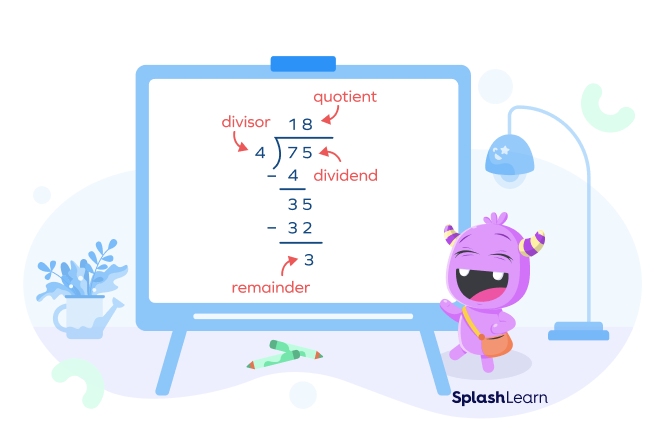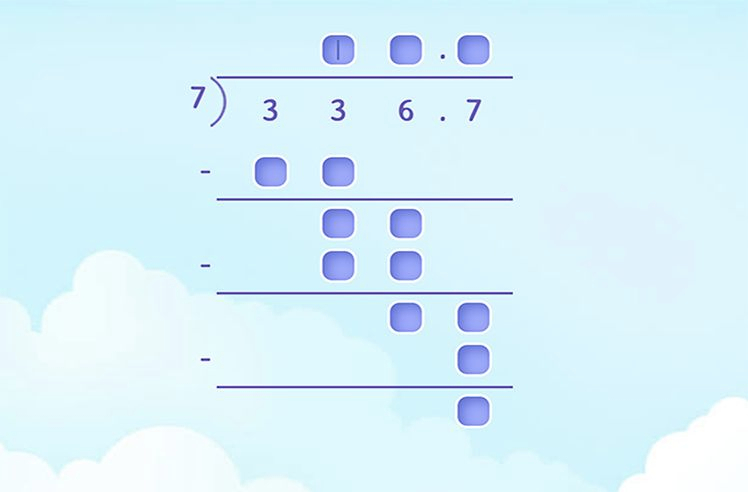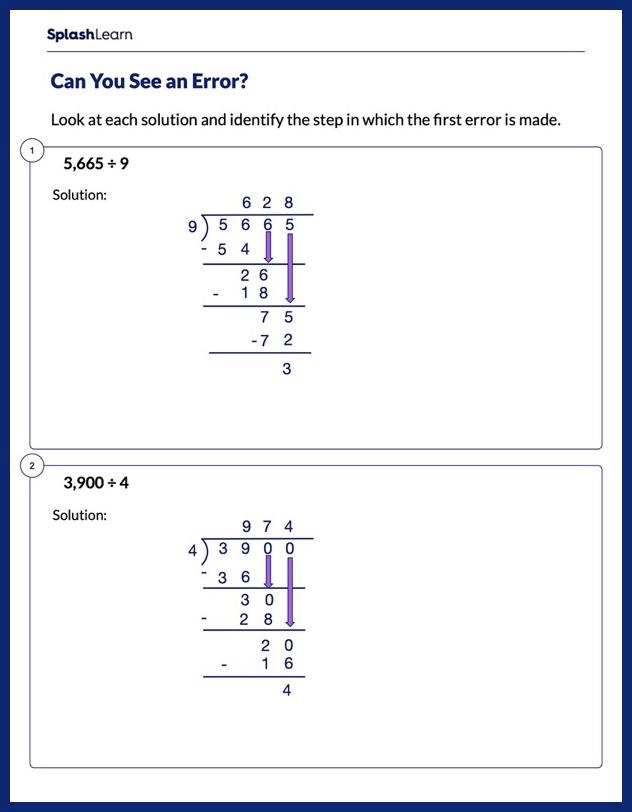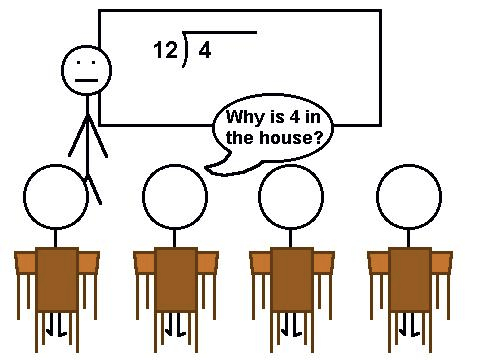Long division can be challenging for kids because it involves many steps and new vocabulary, making it easy to lose track of the process. This complexity often confuses students, especially when bringing down digits or handling remainders. Teaching long division step by step helps kids understand it better. This guide on “how to teach long division to kids” will provide clear steps to simplify learning for kids, making it less overwhelming.
Math & ELA | PreK To Grade 5
Kids see fun.
You see real learning outcomes.
Watch your kids fall in love with math & reading through our scientifically designed curriculum.
Parents, try for free Teachers, use for free
What Should My Child Know Before Learning Long Division?
Before diving into teaching long division, children must have a solid foundation in several key areas. These pre-requisites ensure that they are prepared for the complexities of long division:
- Understanding Multiplication: Kids should be comfortable with multiplication facts up to 12. This knowledge is fundamental because long division requires frequent multiplication to check and subtract products during the division steps.
Here are some fun activities to brush up your child’s understanding of multiplication facts:
- Basic Division Concepts: Ensure children understand the concept of division as sharing or grouping equally. They should be able to perform simple division tasks without remainders, using numbers that are easy to handle.
Here are some fun activities to brush up your child’s understanding of division facts:
- Familiarity with Subtraction: Subtraction is a significant part of the long division process, used to find the difference after multiplying the divisor. Children should be confident in subtracting large numbers, as they will need to do this repeatedly in each step of long division.
Assess how well your kids are versed with subtraction with these fun subtraction games:
- Number Sense: Good number sense, or an understanding of how numbers work and relate to each other, helps children anticipate the results of multiplication and division, making the process of long division smoother and more intuitive.
Ensuring kids are proficient in these areas makes teaching long division more effective, setting them up for success.
How to Teach Long Division in 6 Steps
Step 1: Start with Division Vocabulary
Before learning the steps of long division, kids need to understand the key terms used throughout the process. Knowing these will help them follow long division strategies more easily.
- Dividend: This is the number being divided in the problem. In the long division layout, the dividend is written inside the long division bracket (often called the “house”).
- Divisor: The number dividing the dividend is called the divisor. The divisor is placed outside the long division bracket.
- Quotient: The quotient is the answer or the result of the division problem. This is written above the bracket, aligned with the digits of the dividend being divided.
- Remainder: If the division isn’t exact, there’s an amount left over called the remainder. The remainder is written as “R” followed by the remaining value after the division process.
Step 2: Introduce Long Division Layout

Setting up a long division problem correctly is an essential skill for kids to learn. Here’s how to structure it visually:
- Write the Dividend Inside: Start by placing the dividend (the number being divided) inside the long division bracket, often called the “house.” This makes it clear that this number is the one being split into smaller groups.
- Place the Divisor Outside: Write the divisor (the number doing the dividing) outside, to the left of the bracket. This shows which number will be used repeatedly to divide the dividend into smaller groups.
- Draw Lines for the Quotient: The space above the bracket is where the quotient (the result of the division) will be written. Each digit of the quotient will align above the digit or digits of the dividend that are being divided.
Step 3: Demonstrate With an Examples
1: Set Up the Problem
Write 1564 under the division bar and 27 outside the division bar.
2. Divide
- Look at the first two digits of the dividend (15). Since 15 is less than 27, we need to include the next digit, making it 156.
- Now, determine how many times 27 can fit into 156. 27 goes into 156 a total of 5 times because 27 multiplied by 6 (the next higher number) would exceed 156.
3. Multiply
- Multiply the quotient digit found (5) by the divisor (27), which equals 135.
- Write 135 under 156.
4. Subtract
- Subtract 135 from 156, which equals 21.
- Write 21 below 135.
5. Bring Down
Bring down the next digit of the dividend (the 4 in 1564), making the new number 214.
6. Repeat the Process
- Determine how many times 27 can fit into 214. It fits 7 times (since 27 multiplied by 8 exceeds 214).
- Multiply 27 by 7 (the next quotient digit) to get 189.
- Write 189 under 214, and subtract to find the difference: 214 – 189 = 25.
7. Remainder
- Since there are no more digits to bring down, 25 is the remainder.
- The complete quotient is 57 with a remainder of 25.
After understanding the layout, kids can apply what they’ve learned by playing these games in, each focusing on different levels of difficulty:
- Dividing 2-Digit Numbers by 1-Digit
- Dividing 3-Digit Numbers by 1-Digit
- Dividing 4-Digit Numbers by 1-Digit
- Divide 4-Digit By 2-Digit Numbers
Step 4: Practice Without Bringing Down Zeros
To build a strong foundation in long division, it’s crucial for children to practice problems where they bring down each digit consecutively without the complication of zeros. This helps them focus on mastering the basic steps of division:
Sequential Bringing Down: Start with simpler numbers where each digit in the dividend needs to be brought down one at a time. This practice solidifies their understanding of the division process step by step.
Example Problems:
- 21 ÷ 3: Begin by dividing the first digit. Since 2 divided by 3 doesn’t work, we use 21. 21 divided by 3 equals 7, so 7 is written above the division bar.
- 154 ÷ 7: Start with the first digit. 1 divided by 7 is not possible, so consider the first two digits, 15. 15 divided by 7 equals 2. Write 2 above the division bar, multiply 2 by 7 (which is 14), subtract 14 from 15 to get 1, then bring down the next digit to make it 14. Continue this way.
Step 5: Teach Bringing Down Zeros
Handling zeros can be tricky, but it’s one of the key ways to teach long division. Here’s how to approach problems involving zeros:
Example: 120 ÷ 4
- Divide: Start by dividing the first non-zero digit. Since 1 is smaller than 4, look at the first two digits, 12. Divide 12 by 4 to get 3.
- Write the Quotient: Write 3 above the long division bracket.
- Multiply and Subtract: Multiply 3 by 4 (giving 12) and subtract this from 12, leaving 0.
- Bring Down Zeros: Bring down the next digit, which is 0, making it 0. Divide this 0 by 4 to get 0. Write 0 next to the 3 in the quotient.
- Multiply and Subtract: Multiply 0 by 4 to get 0 and subtract, leaving no remainder.
Step 6: Explain Problems with Remainders
In some cases, division doesn’t result in an even quotient. This means there’s an amount leftover, called a remainder. Here’s how to handle it:
Example: 29 ÷ 4
- Divide: Start by dividing the first digit, 2, by 4. Since 2 is smaller than 4, consider the first two digits, 29.
- Find the Quotient: Divide 29 by 4 to get 7. Write 7 above the long division bracket.
- Multiply and Subtract: Multiply 7 by 4, which gives 28. Subtract 28 from 29, leaving 1.
- Write the Remainder: Since there’s nothing left to bring down, write “R1” (remainder of 1) next to the 7.
Knowing how to recognize and handle remainders is one of the essential long division tricks that help kids understand why not all division problems divide evenly.
5 Fun Ways to Teach Long Division
Practicing long division is crucial for reinforcing the steps and strategies. Here are five effective ways to help kids master this skill:
- Online Long Division Games

Use interactive online games that challenge students to solve division problems step-by-step. These games make learning fun while providing instant feedback to help them understand mistakes.
- Long Division Worksheets

Provide worksheets that start with simpler problems and progressively increase in complexity. Use colorful designs and real-world scenarios to keep kids engaged.
- Flashcards
Create or find flashcards that present division problems on one side and answers on the other. This simple tool is a quick way to reinforce division facts and promote speedy calculations.
- Real-Life Problems
Apply division concepts to real-world situations, like dividing treats among friends or organizing items into equal groups. This practical approach makes long division relatable.
- Group Activities
Collaborative exercises where kids work together to solve division problems encourage discussion and peer learning. This can help clarify challenging steps and foster teamwork.
Conclusion
Learning long division can be challenging, but kids can grasp the concept effectively with clear steps, consistent practice, and engaging resources like games and worksheets. With these strategies on how to teach long division, children will build confidence and become proficient problem-solvers at their own pace.
Frequently Asked Questions (FAQs)
What is an easy way to learn division?
An easy way to learn division is by starting with simple problems and using visual aids like counters or drawings to illustrate the process. Gradually move to more complex problems as confidence builds.
What are some tips for teaching long division to struggling students?
Break down the steps into smaller, manageable parts, and offer lots of practice with engaging resources like games and worksheets. Provide positive reinforcement to encourage their progress and address specific challenges with patience.




















































